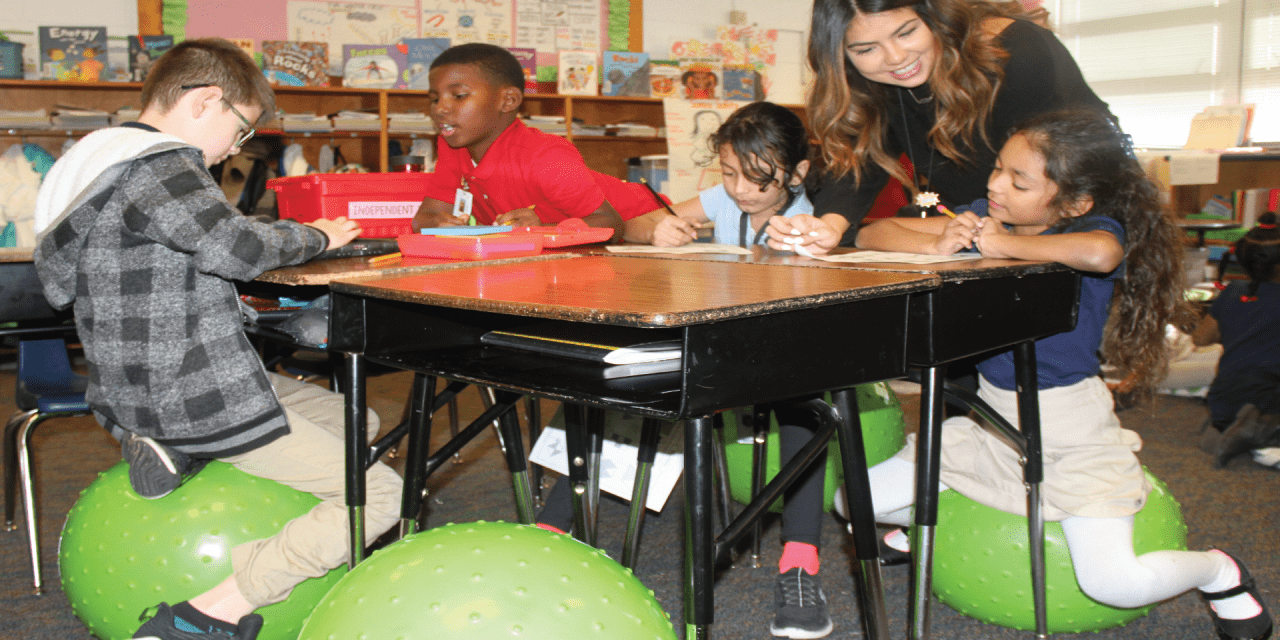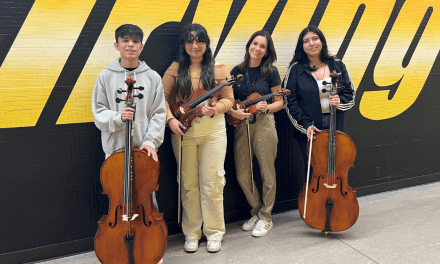#1. Choose a working spot that allows you to do your best work.
This is one of four rules you will see written on a standing chalkboard as you enter Amelia Severns classroom. The third-grade teacher at Johnston Elementary School is one of many practicing the phenomenon of flexible seating. Though the idea has been around for a while, the popular trend is gradually hitting more classrooms year after year. If you ask many educators across the country, the age of the traditional desk and four-legged chair is becoming a thing of the past – a change they gladly welcome.
From pillow-top crates and rockable floor chairs to wobble stools and bouncy balls, third graders in Ms. Severns class are learning on the move. “I wanted to create a comfortable classroom environment that helped my students be successful and enjoy learning,” says Severns. Though some would see this as a classroom gone wild, there is a method behind the madness. “I have absolutely noticed an impact on students,” she states. Focus being one.
Just a few doors down, Severns’ colleague Marie Corral is seeing the same results in her class. “It sounds silly, but it really helps build engagement, trust and community,” adds Corral, who incorporated flexible seating more than three years ago. “I experimented with crates first. Then, I brought the desks down.” By lowering the legs of the desks, Corral created another option where students can work seated on floor cushions. “In my class, students choose a new seat every day.”
Student choice in flex seating is something these two Johnston teachers rave about. “It allows students to be in control and make decisions for themselves,” says Severns. They feel empowered and also learn how to advocate for their wants and needs. “I have a student who discovered she doesn’t like working on the bouncy ball,” Corral mentions. “Whenever she sits at that station, she exchanges the ball for a traditional chair without asking. In that moment, she independently takes action to make herself comfortable and successful.”
Tiffany Vinson, a fifth-grade teacher at John Haley Elementary School, can attest. Vinson recalls a student with a learning condition who, thanks to a class environment where no space is off limits, self-manages himself. “He chooses to sit where he is less distracted. When he feels fidgety, he bounces on the ball to help him focus.” She has also seen the benefit reach students on a personal level. While experiencing transition at home, another student once told Vinson this style of seating helped him feel relaxed during a stressful time.
In Vinson’s classroom, the rhythm and culture of camaraderie is tangible – partly because this particular group of students have been together for two years. Starting with her in fourth grade and now fifth, her students have grown very accustomed to flex seating. From a decrease in tardies to modeling good behavior in order to keep the privilege, students are totally invested. “If they’re comfortable and happy, they want to work for you,” she says two feet away from a student sitting on his knees, bouncing up and down on a rubber ball. What you can’t see is that this same student is having a discussion with his partner about the assignment, totally engaged even though his body is moving.
For John Haley’s Sandra Plascensia, the decision to incorporate the trend was a no brainer. “Students sit more than half of the time they are at school,” says the second-grade teacher. Last year, Plascensia reached her fundraising goal after creating a project on the popular donation platform DonorsChoose. The funds, which she raised in five days by family and friends, helped purchase 17 seats to implement new seating classroom-wide. It’s a project she has been working on for the past two years. Why? Like her colleagues, it’s about the environment – an environment that not only impacts the students, but the teachers as well.
“I want to go to work every day and not feel like I’m at work,” explains Kelsey Staudenecker, fifth-grade teacher at Brandenburg Elementary School. For her, the motivation behind transforming her room was to create an excitement she and her students could share together. With a life-size teepee sitting in the corner, she is already looking ahead with more ideas on the horizon, including yoga mats and activity trays. “My ultimate goal is to have a high-functioning room with seating and standing options that benefit every learning style and need.”
While they all agree flexible seating is not for every teacher or every student, this unorthodox way has proven successful for these educators. “In elementary school, we were seated in rows,” remembers Corral. “Writing on desks with a marker, talking out loud and sitting next to your friends was a no-no!” The concept of school and what makes a successful classroom has changed and for the better. As educators are given license to think outside the box, who knows what’s next. The day of collaborative spaces is here – what Vinson calls the Starbucks effect.






